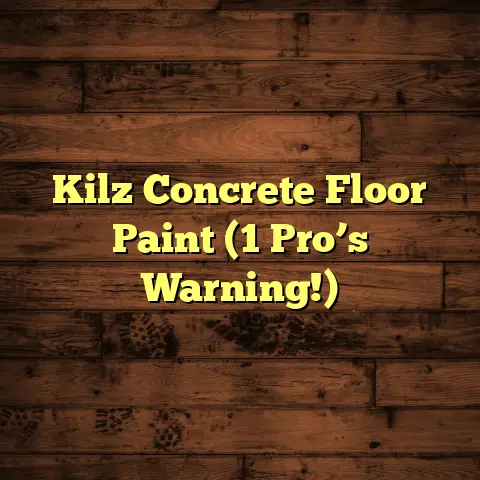Tile To Wood Transitions (4 Pro Secrets!)
Imagine stepping into a home where the warm, inviting tones of hardwood flow seamlessly into the cool, clean lines of tile.
A vibrant rug, bursting with color, sits perfectly at the transition, drawing your eye and adding a touch of personality.
The interplay of materials is not just functional; it’s a statement, a carefully curated detail that elevates the entire space.
That’s the power of a well-executed tile-to-wood transition.
As a flooring contractor with years of experience, I’ve seen firsthand how these transitions can make or break a design.
They’re not just about joining two different flooring types; they’re about creating a cohesive and visually appealing flow throughout your home.
And believe me, there’s more to it than just slapping down a transition strip!
In this article, I’m going to share four pro secrets that will help you master the art of tile-to-wood transitions.
We’ll dive deep into the details, from selecting the right materials to achieving perfect height alignment and incorporating design elements that will truly make your space shine.
So, grab a coffee, settle in, and let’s get started!
Section 1: Understanding Tile to
Wood Transitions
So, what exactly is a tile-to-wood transition?
Simply put, it’s the point where your tile flooring meets your wood flooring.
But it’s so much more than just a meeting point.
It’s a design element that plays a crucial role in both the functionality and aesthetics of your home.
Why are these transitions so important?
Well, for starters, they provide a safe and smooth surface to walk on.
Imagine stubbing your toe every time you walk from your kitchen (tile) to your living room (wood).
Not fun, right?
Transitions eliminate tripping hazards and create a more comfortable living environment.
Beyond safety, transitions also serve an important aesthetic purpose.
They can define different areas within your home, creating a visual separation between rooms.
They can also add a touch of elegance and sophistication to your design, tying everything together in a seamless and stylish way.
Think of it like this: a well-chosen transition is like the perfect accessory that completes an outfit.
Where are tile-to-wood transitions typically found?
You’ll often see them in areas where you want to separate a “wet” area from a “dry” area.
Common examples include:
-
Kitchen to Living Room: The durable, water-resistant tile in the kitchen transitions to the warmer, more comfortable wood in the living room.
-
Bathroom to Hallway: Again, tile protects against moisture in the bathroom, while wood adds warmth to the hallway.
-
Entryway to Living Room: Tile in the entryway can handle dirt and moisture tracked in from outside, transitioning to wood in the more formal living space.
What about the tile and wood themselves?
The possibilities are endless!
You can choose from a wide variety of tile styles, from classic ceramic and porcelain to modern glass and stone.
Wood flooring options are equally diverse, ranging from traditional hardwood like oak and maple to more exotic species like bamboo and Brazilian cherry.
The key is to choose materials that complement each other and reflect your personal style.
For example, you might pair a rustic, textured tile with a distressed hardwood for a farmhouse-chic look.
Or, you could opt for a sleek, minimalist tile with a light-colored wood for a more contemporary feel.
I’ve had clients who wanted a bold contrast, pairing dark slate tile with light maple wood.
The key here is the right transition strip to tie it all together. More on that later!
Here’s a quick tip: Consider the undertones of both your tile and wood.
Do they have warm undertones (yellow, orange, red) or cool undertones (blue, green, gray)?
Pairing materials with similar undertones will create a more harmonious and cohesive look.
Section 2: Pro Secret #1 –
Selecting the Right Transition Strip
Okay, now let’s get down to the nitty-gritty: choosing the right transition strip.
This is where the magic happens, folks!
The transition strip is the unsung hero of the flooring world.
It’s the piece that bridges the gap between your tile and wood, creating a smooth, safe, and visually appealing transition.
But with so many different types of transition strips on the market, how do you choose the right one?
Let’s break it down:
Types of Transition Strips:
-
T-Molding: As the name suggests, T-molding is shaped like a “T.”
It’s typically used when the tile and wood are the same height.
The top of the “T” sits flush with both surfaces, creating a seamless transition.
-
Reducer Strip: Reducer strips are used when the tile and wood are different heights.
They have a sloped profile that gradually transitions from the higher surface (usually the tile) to the lower surface (usually the wood).
-
End Cap: End caps are used when the tile or wood flooring ends abruptly, such as at a doorway or against a wall.
They provide a finished edge and prevent tripping hazards.
-
Square Nose: Square nose transitions offer a clean, modern look.
They create a 90-degree angle between the two flooring surfaces.
-
Overlap Reducer: This type is useful when you need to cover a larger height difference between the tile and wood.
It overlaps slightly onto both surfaces.
Choosing the Right Material:
The material of your transition strip is just as important as the type.
Here are some common options:
-
Wood: Wood transition strips are a classic choice, especially when transitioning to hardwood flooring.
They can be stained to match your wood flooring for a seamless look.
However, wood is not ideal for areas with high moisture, such as bathrooms.
-
Metal: Metal transition strips are durable and long-lasting.
They come in a variety of finishes, such as aluminum, stainless steel, and brass.
Metal is a good choice for high-traffic areas and areas with moisture.
-
Laminate/Vinyl: Laminate or vinyl transition strips are a budget-friendly option.
They are available in a wide range of colors and patterns to match your flooring.
However, they are not as durable as wood or metal.
Factors to Consider:
-
Height Difference: This is the most important factor.
Measure the height difference between your tile and wood flooring to determine which type of transition strip you need.
-
Durability: Consider the amount of traffic the area will receive.
For high-traffic areas, choose a durable material like metal or solid wood.
-
Color Matching: Choose a transition strip that complements both your tile and wood flooring.
You can either match the color exactly or choose a contrasting color for a more dramatic look.
-
Installation Method: Some transition strips are glued down, while others are screwed or nailed in place.
Choose a method that is appropriate for your flooring and your skill level.
Pro Tip: When in doubt, err on the side of caution and choose a transition strip that is slightly larger than you think you need.
You can always trim it down to size, but you can’t make it bigger!
Also, consider the subfloor. Is it concrete or wood?
This will affect the type of adhesive or fasteners you’ll need.
I once had a client who insisted on using a wood transition strip in her bathroom.
Despite my warnings, she went ahead and installed it.
A few months later, the strip was warped and moldy.
She ended up having to replace it with a metal one.
Learn from her mistake!
Section 3: Pro Secret #2 –
Achieving the Perfect Height Alignment
Alright, let’s talk about height alignment.
This is where things can get a little tricky, but trust me, it’s worth the effort.
A smooth, seamless transition is all about achieving the perfect height alignment between your tile and wood flooring.
If one surface is significantly higher or lower than the other, you’ll end up with a tripping hazard and an unsightly transition.
Why is height alignment so important?
-
Safety: As I mentioned earlier, uneven surfaces can be dangerous.
Proper height alignment eliminates tripping hazards and creates a safer living environment.
-
Aesthetics: A smooth, seamless transition looks much more professional and polished.
It shows that you’ve paid attention to detail and that you care about the overall look of your home.
-
Longevity: Uneven transitions can put stress on your flooring, leading to cracks, chips, and other damage.
Proper height alignment helps to prolong the life of your flooring.
Measuring and Cutting:
The first step is to accurately measure the height difference between your tile and wood flooring.
Use a level and a ruler or measuring tape to get an accurate reading.
Once you know the height difference, you can start cutting your flooring to ensure a perfect fit.
If your wood flooring is too thick, you may need to sand it down or use a planer to reduce its thickness.
If your tile flooring is too thin, you may need to add a layer of underlayment to raise its height.
Leveling Techniques and Tools:
Leveling is crucial for achieving a smooth transition, especially if your subfloor is uneven.
Here are some common leveling techniques and tools:
-
Self-Leveling Underlayment: This is a cement-based product that you pour onto your subfloor.
It spreads out evenly and creates a smooth, level surface for your flooring.
-
Shims: Shims are thin pieces of wood or plastic that you can use to fill in gaps and level out uneven surfaces.
-
Leveling Compound: This is a thick paste that you can use to fill in small imperfections and level out minor unevenness.
-
Laser Level: A laser level projects a beam of light that you can use to ensure that your flooring is level.
Common Pitfalls to Avoid:
-
Ignoring the Subfloor: The condition of your subfloor can have a big impact on the success of your transition.
Make sure your subfloor is clean, dry, and level before you start installing your flooring.
-
Using the Wrong Tools: Using the wrong tools can make the job much more difficult and can even damage your flooring.
Invest in quality tools that are designed for the job.
-
Rushing the Process: Don’t try to rush the installation process.
Take your time and pay attention to detail.
I remember one job where the homeowner tried to save money by skipping the self-leveling underlayment.
His subfloor was severely uneven, and the resulting transition was a disaster.
He ended up having to tear everything out and start over.
Sometimes, saving a little money upfront can end up costing you more in the long run.
Section 4: Pro Secret #3 –
Incorporating Design Elements
Okay, now for the fun part: incorporating design elements to make your tile-to-wood transitions really stand out!
This is where you can get creative and add your own personal touch to your space.
Color, Patterns, and Textures:
Don’t be afraid to play with color, patterns, and textures to create visual interest in your transition areas.
-
Contrasting Colors: Use contrasting colors to create a bold and dramatic look.
For example, you could pair a dark wood flooring with a light-colored tile.
-
Complementary Colors: Use complementary colors to create a more subtle and harmonious look.
For example, you could pair a warm-toned wood flooring with a tile that has similar undertones.
-
Patterns: Incorporate patterns into your transition areas to add visual interest.
For example, you could use a mosaic tile border to separate your tile and wood flooring.
-
Textures: Use different textures to create a tactile and visually appealing transition.
For example, you could pair a smooth, polished tile with a textured wood flooring.
Accent Tiles and Borders:
Accent tiles and borders are a great way to add a unique and personalized touch to your tile-to-wood transitions.
-
Mosaic Tiles: Mosaic tiles are small, decorative tiles that come in a variety of colors, shapes, and sizes.
They can be used to create intricate patterns and designs.
-
Glass Tiles: Glass tiles are a modern and stylish option.
They come in a variety of colors and finishes, and they can add a touch of elegance to your transition areas.
-
Stone Tiles: Stone tiles are a natural and durable option.
They come in a variety of colors and textures, and they can add a rustic or earthy feel to your transition areas.
Coordinating with the Overall Theme:
It’s important to coordinate your transition designs with the overall theme of your room or home.
-
Farmhouse Chic: If you’re going for a farmhouse-chic look, you might use a rustic, textured tile with a distressed wood flooring and a simple wood transition strip.
-
Modern Minimalist: If you’re going for a modern minimalist look, you might use a sleek, minimalist tile with a light-colored wood flooring and a metal transition strip.
-
Traditional Elegance: If you’re going for a traditional elegant look, you might use a classic ceramic tile with a rich, dark wood flooring and a decorative stone border.
I once helped a client design a tile-to-wood transition that incorporated a custom-made mosaic border.
The border featured a repeating pattern of flowers and leaves, and it perfectly complemented the overall theme of her garden-inspired kitchen.
It was a truly stunning transition that added a unique and personalized touch to her home.
Don’t be afraid to experiment and try new things!
The possibilities are endless when it comes to designing your tile-to-wood transitions.
Section 5: Pro Secret #4 –
Maintenance and Longevity of Transitions
Okay, you’ve got your beautiful tile-to-wood transition installed.
Now, how do you keep it looking great for years to come?
Maintenance is key to ensuring the longevity of your transitions.
Cleaning Tips:
-
Tile: Clean your tile flooring regularly with a mild detergent and water.
Avoid using harsh chemicals or abrasive cleaners, as they can damage the surface of the tile.
-
Wood: Clean your wood flooring with a wood floor cleaner that is specifically designed for your type of wood.
Avoid using excessive water, as it can damage the wood.
-
Transition Strips: Clean your transition strips with a damp cloth and a mild detergent.
Avoid using abrasive cleaners, as they can scratch the surface.
Assessing and Replacing Transition Strips:
Regularly inspect your transition strips for signs of wear and tear, such as cracks, chips, or loose fasteners.
If you notice any damage, it’s important to replace the transition strip as soon as possible to prevent further damage to your flooring.
Longevity of Materials:
The longevity of your tile-to-wood transitions will depend on the materials you choose.
-
Tile: Tile is a very durable material that can last for decades with proper maintenance.
-
Wood: Wood flooring can also last for many years, but it is more susceptible to damage from moisture and scratches.
-
Transition Strips: The lifespan of your transition strips will depend on the material they are made of.
Metal transition strips are typically the most durable, while laminate or vinyl transition strips may need to be replaced more frequently.
Pro Tip: Apply a sealant to your tile grout every year or two to prevent stains and water damage.
Also, use furniture pads under the legs of your furniture to protect your wood flooring from scratches.
I had a client who neglected to maintain her tile-to-wood transition.
Over time, the tile grout became stained and cracked, and the wood flooring became scratched and faded.
Eventually, she had to replace the entire transition, which cost her a lot of time and money.
Don’t let this happen to you!
By following these simple maintenance tips, you can keep your tile-to-wood transitions looking great for years to come.
Conclusion
So, there you have it: four pro secrets to mastering tile-to-wood transitions.
We’ve covered everything from understanding the importance of transitions to selecting the right materials, achieving perfect height alignment, incorporating design elements, and maintaining your transitions for longevity.
Remember, tile-to-wood transitions are more than just a functional necessity.
They’re an opportunity to enhance the overall aesthetic and functionality of your space.
By paying attention to detail and following these pro secrets, you can create transitions that are both beautiful and practical.
So, whether you’re planning a full-scale renovation or simply looking to upgrade your existing flooring, I encourage you to consider the power of tile-to-wood transitions.
With a little planning and effort, you can transform your home into an inviting and cohesive environment that you’ll love for years to come.
Call to Action
Now it’s your turn!
I’d love to hear about your own flooring projects and experiences with tile-to-wood transitions.
Have you tried any of these pro secrets?
Do you have any tips or tricks of your own to share?
Feel free to leave a comment below and let me know.
And if you’re feeling inspired, why not start planning your own flooring project today?
Whether you’re a seasoned DIYer or a first-time homeowner, I hope this article has given you the knowledge and confidence to tackle your next flooring project with ease.
And if you need any professional advice or assistance, don’t hesitate to reach out to a qualified flooring contractor in your area.
Together, we can embrace the beauty and potential of tile-to-wood transitions and transform our living spaces into something truly special.





